Past, Present and Future of Wearable Technology
VerifiedAdded on 2022/11/11
|10
|2276
|131
AI Summary
This literature review discusses the past, present and future of wearable technology, including fitness trackers, smart watches, and other wearable devices. It also explores the potential for future innovations in the industry.
Contribute Materials
Your contribution can guide someone’s learning journey. Share your
documents today.
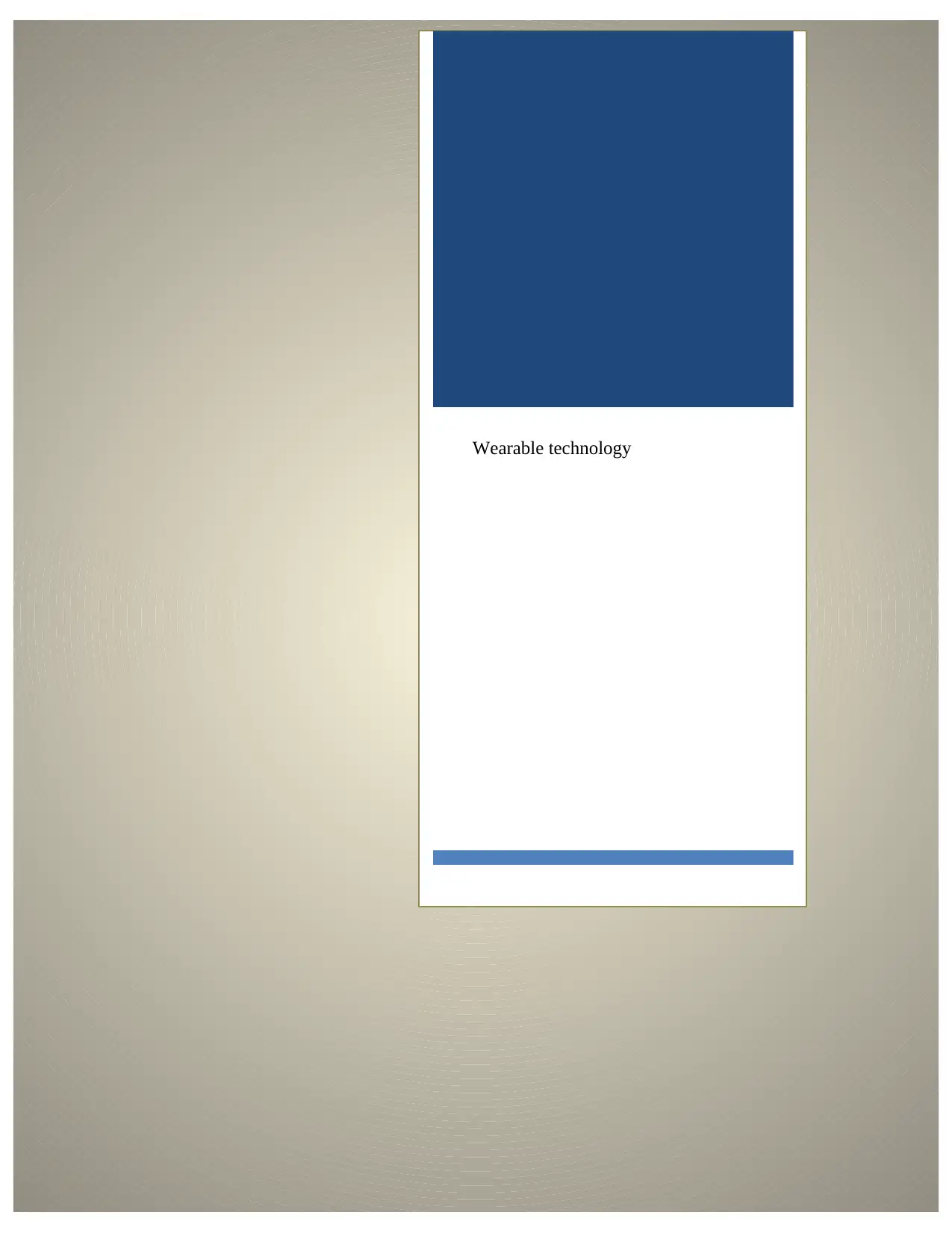
Wearable technology
Secure Best Marks with AI Grader
Need help grading? Try our AI Grader for instant feedback on your assignments.
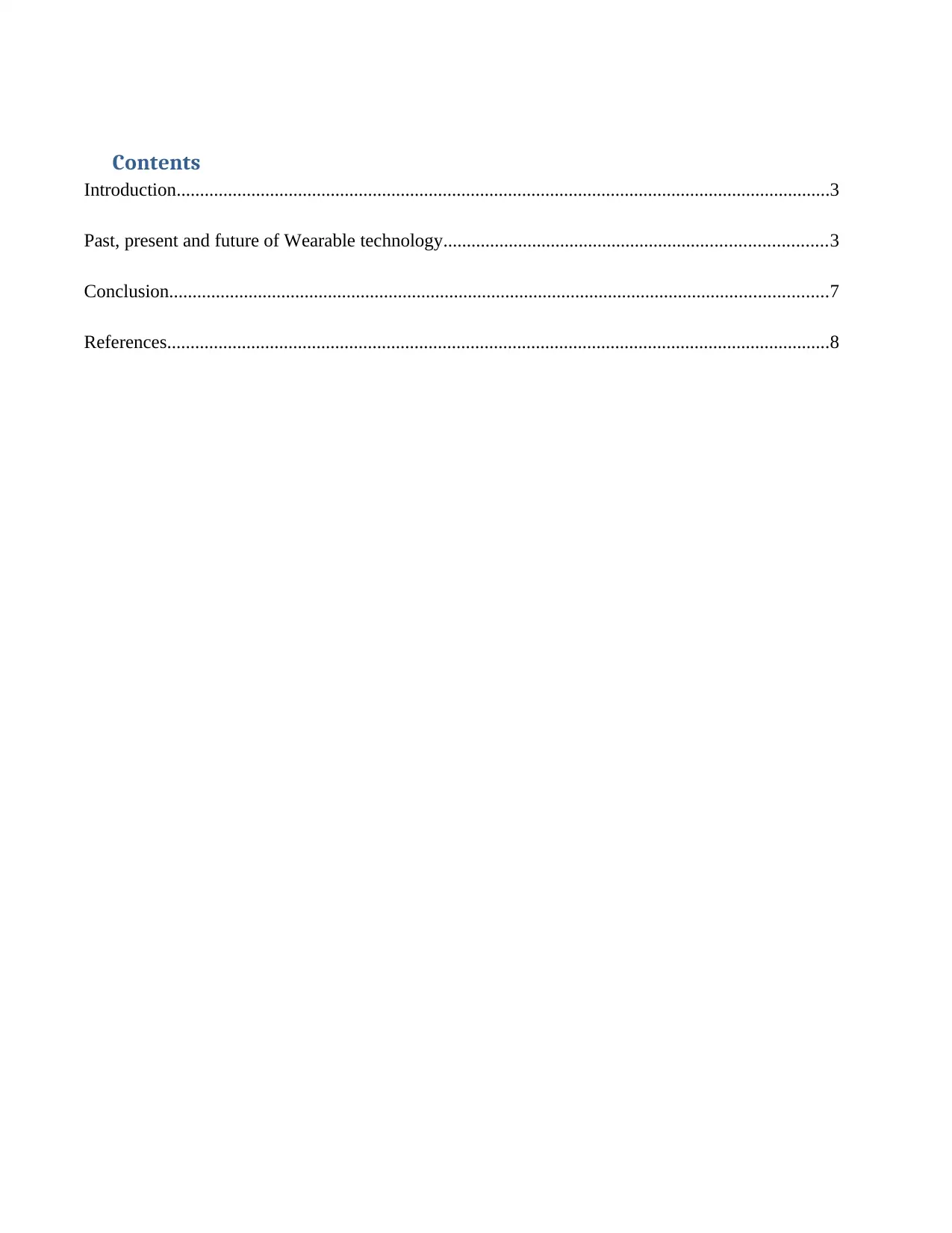
Contents
Introduction............................................................................................................................................3
Past, present and future of Wearable technology..................................................................................3
Conclusion.............................................................................................................................................7
References..............................................................................................................................................8
Introduction............................................................................................................................................3
Past, present and future of Wearable technology..................................................................................3
Conclusion.............................................................................................................................................7
References..............................................................................................................................................8

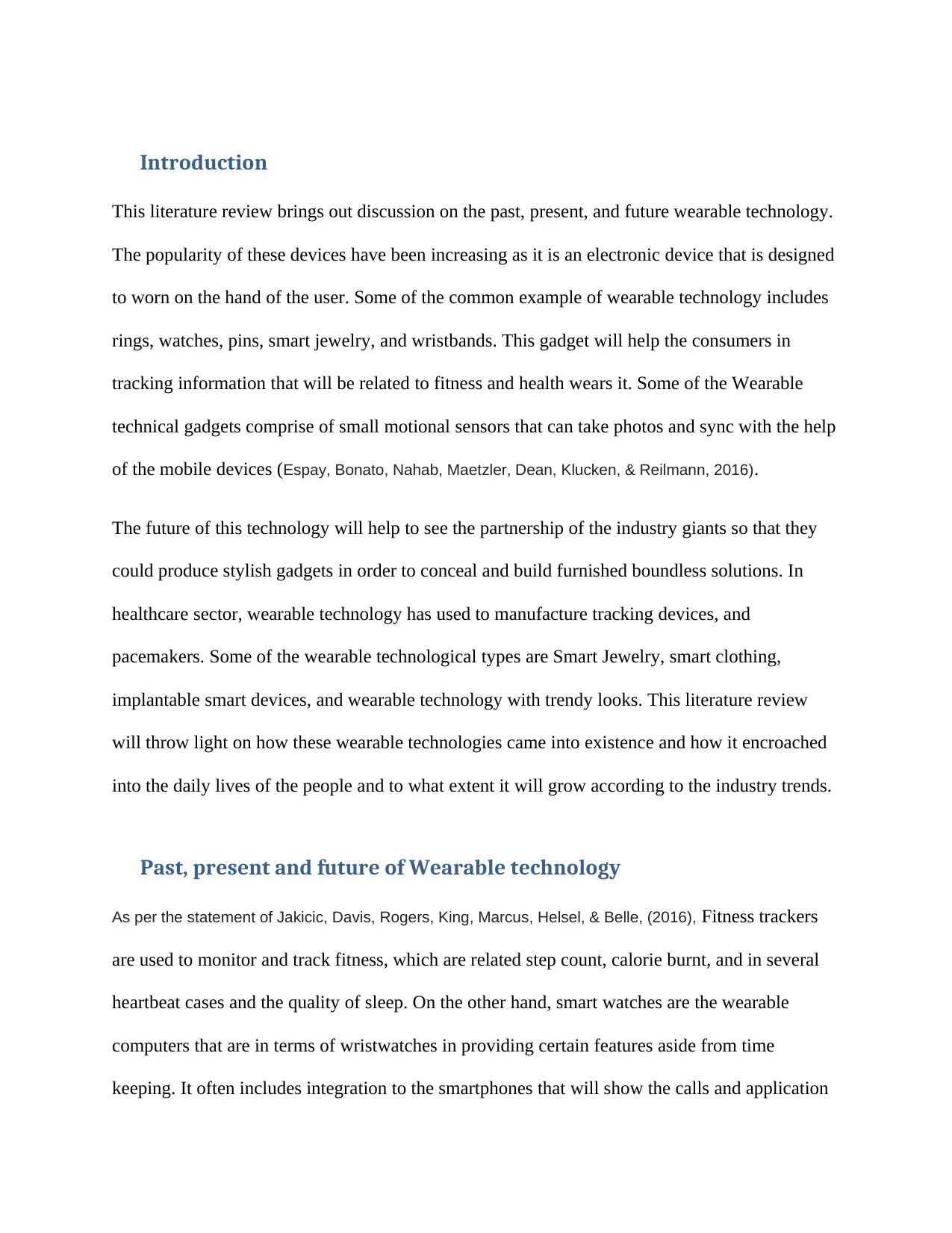
Introduction
This literature review brings out discussion on the past, present, and future wearable technology.
The popularity of these devices have been increasing as it is an electronic device that is designed
to worn on the hand of the user. Some of the common example of wearable technology includes
rings, watches, pins, smart jewelry, and wristbands. This gadget will help the consumers in
tracking information that will be related to fitness and health wears it. Some of the Wearable
technical gadgets comprise of small motional sensors that can take photos and sync with the help
of the mobile devices (Espay, Bonato, Nahab, Maetzler, Dean, Klucken, & Reilmann, 2016).
The future of this technology will help to see the partnership of the industry giants so that they
could produce stylish gadgets in order to conceal and build furnished boundless solutions. In
healthcare sector, wearable technology has used to manufacture tracking devices, and
pacemakers. Some of the wearable technological types are Smart Jewelry, smart clothing,
implantable smart devices, and wearable technology with trendy looks. This literature review
will throw light on how these wearable technologies came into existence and how it encroached
into the daily lives of the people and to what extent it will grow according to the industry trends.
Past, present and future of Wearable technology
As per the statement of Jakicic, Davis, Rogers, King, Marcus, Helsel, & Belle, (2016), Fitness trackers
are used to monitor and track fitness, which are related step count, calorie burnt, and in several
heartbeat cases and the quality of sleep. On the other hand, smart watches are the wearable
computers that are in terms of wristwatches in providing certain features aside from time
keeping. It often includes integration to the smartphones that will show the calls and application
This literature review brings out discussion on the past, present, and future wearable technology.
The popularity of these devices have been increasing as it is an electronic device that is designed
to worn on the hand of the user. Some of the common example of wearable technology includes
rings, watches, pins, smart jewelry, and wristbands. This gadget will help the consumers in
tracking information that will be related to fitness and health wears it. Some of the Wearable
technical gadgets comprise of small motional sensors that can take photos and sync with the help
of the mobile devices (Espay, Bonato, Nahab, Maetzler, Dean, Klucken, & Reilmann, 2016).
The future of this technology will help to see the partnership of the industry giants so that they
could produce stylish gadgets in order to conceal and build furnished boundless solutions. In
healthcare sector, wearable technology has used to manufacture tracking devices, and
pacemakers. Some of the wearable technological types are Smart Jewelry, smart clothing,
implantable smart devices, and wearable technology with trendy looks. This literature review
will throw light on how these wearable technologies came into existence and how it encroached
into the daily lives of the people and to what extent it will grow according to the industry trends.
Past, present and future of Wearable technology
As per the statement of Jakicic, Davis, Rogers, King, Marcus, Helsel, & Belle, (2016), Fitness trackers
are used to monitor and track fitness, which are related step count, calorie burnt, and in several
heartbeat cases and the quality of sleep. On the other hand, smart watches are the wearable
computers that are in terms of wristwatches in providing certain features aside from time
keeping. It often includes integration to the smartphones that will show the calls and application
Secure Best Marks with AI Grader
Need help grading? Try our AI Grader for instant feedback on your assignments.
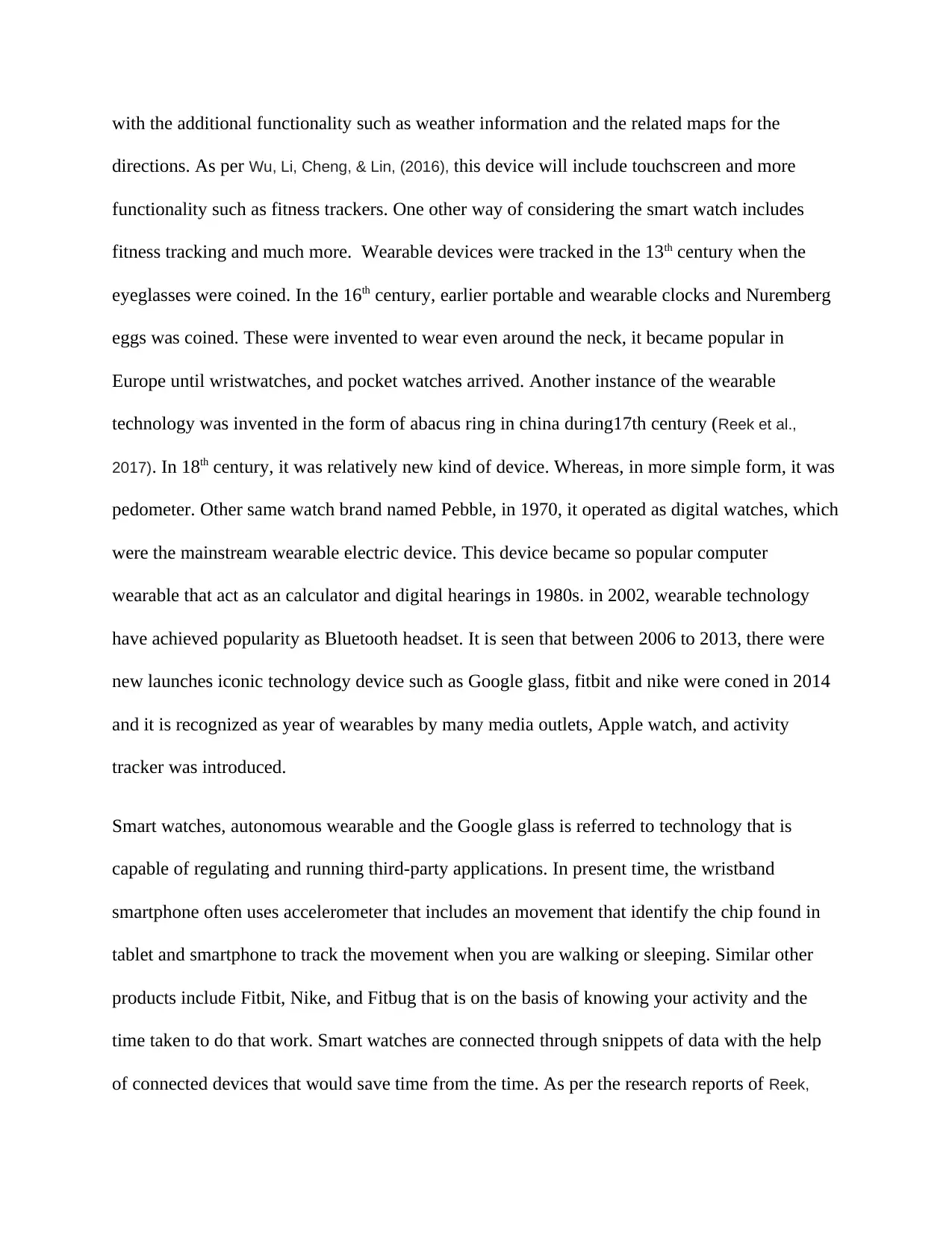
with the additional functionality such as weather information and the related maps for the
directions. As per Wu, Li, Cheng, & Lin, (2016), this device will include touchscreen and more
functionality such as fitness trackers. One other way of considering the smart watch includes
fitness tracking and much more. Wearable devices were tracked in the 13th century when the
eyeglasses were coined. In the 16th century, earlier portable and wearable clocks and Nuremberg
eggs was coined. These were invented to wear even around the neck, it became popular in
Europe until wristwatches, and pocket watches arrived. Another instance of the wearable
technology was invented in the form of abacus ring in china during17th century (Reek et al.,
2017). In 18th century, it was relatively new kind of device. Whereas, in more simple form, it was
pedometer. Other same watch brand named Pebble, in 1970, it operated as digital watches, which
were the mainstream wearable electric device. This device became so popular computer
wearable that act as an calculator and digital hearings in 1980s. in 2002, wearable technology
have achieved popularity as Bluetooth headset. It is seen that between 2006 to 2013, there were
new launches iconic technology device such as Google glass, fitbit and nike were coned in 2014
and it is recognized as year of wearables by many media outlets, Apple watch, and activity
tracker was introduced.
Smart watches, autonomous wearable and the Google glass is referred to technology that is
capable of regulating and running third-party applications. In present time, the wristband
smartphone often uses accelerometer that includes an movement that identify the chip found in
tablet and smartphone to track the movement when you are walking or sleeping. Similar other
products include Fitbit, Nike, and Fitbug that is on the basis of knowing your activity and the
time taken to do that work. Smart watches are connected through snippets of data with the help
of connected devices that would save time from the time. As per the research reports of Reek,
directions. As per Wu, Li, Cheng, & Lin, (2016), this device will include touchscreen and more
functionality such as fitness trackers. One other way of considering the smart watch includes
fitness tracking and much more. Wearable devices were tracked in the 13th century when the
eyeglasses were coined. In the 16th century, earlier portable and wearable clocks and Nuremberg
eggs was coined. These were invented to wear even around the neck, it became popular in
Europe until wristwatches, and pocket watches arrived. Another instance of the wearable
technology was invented in the form of abacus ring in china during17th century (Reek et al.,
2017). In 18th century, it was relatively new kind of device. Whereas, in more simple form, it was
pedometer. Other same watch brand named Pebble, in 1970, it operated as digital watches, which
were the mainstream wearable electric device. This device became so popular computer
wearable that act as an calculator and digital hearings in 1980s. in 2002, wearable technology
have achieved popularity as Bluetooth headset. It is seen that between 2006 to 2013, there were
new launches iconic technology device such as Google glass, fitbit and nike were coned in 2014
and it is recognized as year of wearables by many media outlets, Apple watch, and activity
tracker was introduced.
Smart watches, autonomous wearable and the Google glass is referred to technology that is
capable of regulating and running third-party applications. In present time, the wristband
smartphone often uses accelerometer that includes an movement that identify the chip found in
tablet and smartphone to track the movement when you are walking or sleeping. Similar other
products include Fitbit, Nike, and Fitbug that is on the basis of knowing your activity and the
time taken to do that work. Smart watches are connected through snippets of data with the help
of connected devices that would save time from the time. As per the research reports of Reek,
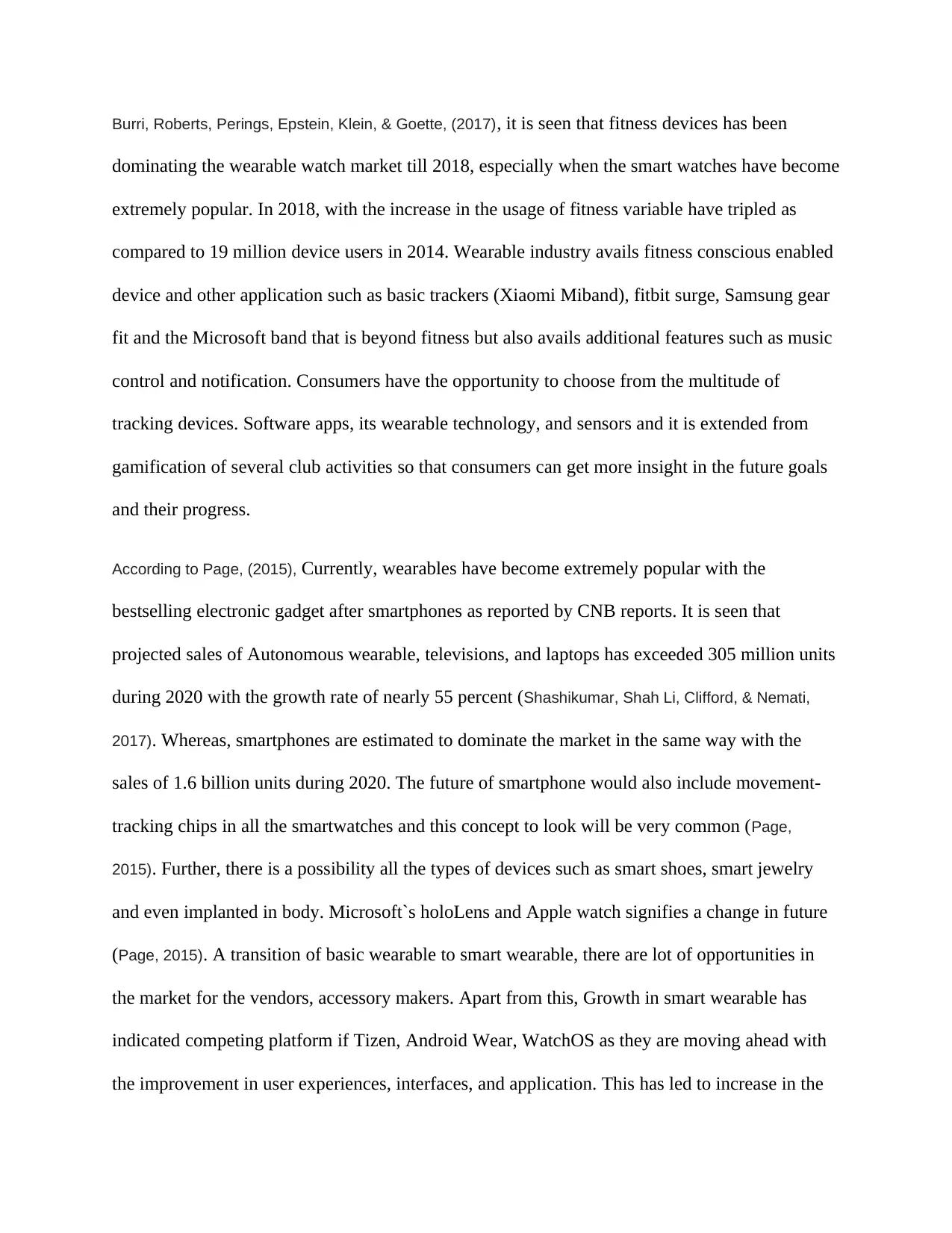
Burri, Roberts, Perings, Epstein, Klein, & Goette, (2017), it is seen that fitness devices has been
dominating the wearable watch market till 2018, especially when the smart watches have become
extremely popular. In 2018, with the increase in the usage of fitness variable have tripled as
compared to 19 million device users in 2014. Wearable industry avails fitness conscious enabled
device and other application such as basic trackers (Xiaomi Miband), fitbit surge, Samsung gear
fit and the Microsoft band that is beyond fitness but also avails additional features such as music
control and notification. Consumers have the opportunity to choose from the multitude of
tracking devices. Software apps, its wearable technology, and sensors and it is extended from
gamification of several club activities so that consumers can get more insight in the future goals
and their progress.
According to Page, (2015), Currently, wearables have become extremely popular with the
bestselling electronic gadget after smartphones as reported by CNB reports. It is seen that
projected sales of Autonomous wearable, televisions, and laptops has exceeded 305 million units
during 2020 with the growth rate of nearly 55 percent (Shashikumar, Shah Li, Clifford, & Nemati,
2017). Whereas, smartphones are estimated to dominate the market in the same way with the
sales of 1.6 billion units during 2020. The future of smartphone would also include movement-
tracking chips in all the smartwatches and this concept to look will be very common (Page,
2015). Further, there is a possibility all the types of devices such as smart shoes, smart jewelry
and even implanted in body. Microsoft`s holoLens and Apple watch signifies a change in future
(Page, 2015). A transition of basic wearable to smart wearable, there are lot of opportunities in
the market for the vendors, accessory makers. Apart from this, Growth in smart wearable has
indicated competing platform if Tizen, Android Wear, WatchOS as they are moving ahead with
the improvement in user experiences, interfaces, and application. This has led to increase in the
dominating the wearable watch market till 2018, especially when the smart watches have become
extremely popular. In 2018, with the increase in the usage of fitness variable have tripled as
compared to 19 million device users in 2014. Wearable industry avails fitness conscious enabled
device and other application such as basic trackers (Xiaomi Miband), fitbit surge, Samsung gear
fit and the Microsoft band that is beyond fitness but also avails additional features such as music
control and notification. Consumers have the opportunity to choose from the multitude of
tracking devices. Software apps, its wearable technology, and sensors and it is extended from
gamification of several club activities so that consumers can get more insight in the future goals
and their progress.
According to Page, (2015), Currently, wearables have become extremely popular with the
bestselling electronic gadget after smartphones as reported by CNB reports. It is seen that
projected sales of Autonomous wearable, televisions, and laptops has exceeded 305 million units
during 2020 with the growth rate of nearly 55 percent (Shashikumar, Shah Li, Clifford, & Nemati,
2017). Whereas, smartphones are estimated to dominate the market in the same way with the
sales of 1.6 billion units during 2020. The future of smartphone would also include movement-
tracking chips in all the smartwatches and this concept to look will be very common (Page,
2015). Further, there is a possibility all the types of devices such as smart shoes, smart jewelry
and even implanted in body. Microsoft`s holoLens and Apple watch signifies a change in future
(Page, 2015). A transition of basic wearable to smart wearable, there are lot of opportunities in
the market for the vendors, accessory makers. Apart from this, Growth in smart wearable has
indicated competing platform if Tizen, Android Wear, WatchOS as they are moving ahead with
the improvement in user experiences, interfaces, and application. This has led to increase in the
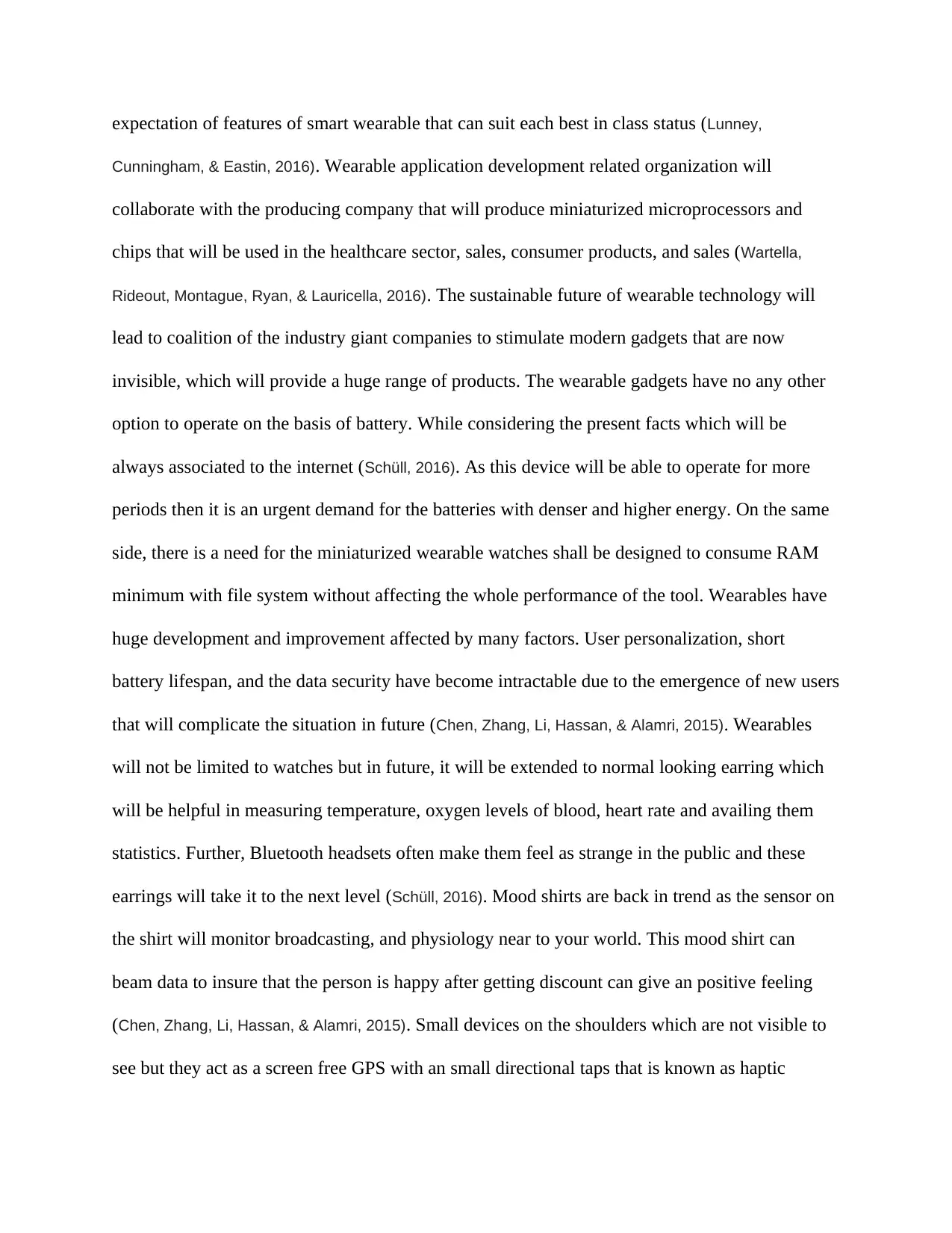
expectation of features of smart wearable that can suit each best in class status (Lunney,
Cunningham, & Eastin, 2016). Wearable application development related organization will
collaborate with the producing company that will produce miniaturized microprocessors and
chips that will be used in the healthcare sector, sales, consumer products, and sales (Wartella,
Rideout, Montague, Ryan, & Lauricella, 2016). The sustainable future of wearable technology will
lead to coalition of the industry giant companies to stimulate modern gadgets that are now
invisible, which will provide a huge range of products. The wearable gadgets have no any other
option to operate on the basis of battery. While considering the present facts which will be
always associated to the internet (Schüll, 2016). As this device will be able to operate for more
periods then it is an urgent demand for the batteries with denser and higher energy. On the same
side, there is a need for the miniaturized wearable watches shall be designed to consume RAM
minimum with file system without affecting the whole performance of the tool. Wearables have
huge development and improvement affected by many factors. User personalization, short
battery lifespan, and the data security have become intractable due to the emergence of new users
that will complicate the situation in future (Chen, Zhang, Li, Hassan, & Alamri, 2015). Wearables
will not be limited to watches but in future, it will be extended to normal looking earring which
will be helpful in measuring temperature, oxygen levels of blood, heart rate and availing them
statistics. Further, Bluetooth headsets often make them feel as strange in the public and these
earrings will take it to the next level (Schüll, 2016). Mood shirts are back in trend as the sensor on
the shirt will monitor broadcasting, and physiology near to your world. This mood shirt can
beam data to insure that the person is happy after getting discount can give an positive feeling
(Chen, Zhang, Li, Hassan, & Alamri, 2015). Small devices on the shoulders which are not visible to
see but they act as a screen free GPS with an small directional taps that is known as haptic
Cunningham, & Eastin, 2016). Wearable application development related organization will
collaborate with the producing company that will produce miniaturized microprocessors and
chips that will be used in the healthcare sector, sales, consumer products, and sales (Wartella,
Rideout, Montague, Ryan, & Lauricella, 2016). The sustainable future of wearable technology will
lead to coalition of the industry giant companies to stimulate modern gadgets that are now
invisible, which will provide a huge range of products. The wearable gadgets have no any other
option to operate on the basis of battery. While considering the present facts which will be
always associated to the internet (Schüll, 2016). As this device will be able to operate for more
periods then it is an urgent demand for the batteries with denser and higher energy. On the same
side, there is a need for the miniaturized wearable watches shall be designed to consume RAM
minimum with file system without affecting the whole performance of the tool. Wearables have
huge development and improvement affected by many factors. User personalization, short
battery lifespan, and the data security have become intractable due to the emergence of new users
that will complicate the situation in future (Chen, Zhang, Li, Hassan, & Alamri, 2015). Wearables
will not be limited to watches but in future, it will be extended to normal looking earring which
will be helpful in measuring temperature, oxygen levels of blood, heart rate and availing them
statistics. Further, Bluetooth headsets often make them feel as strange in the public and these
earrings will take it to the next level (Schüll, 2016). Mood shirts are back in trend as the sensor on
the shirt will monitor broadcasting, and physiology near to your world. This mood shirt can
beam data to insure that the person is happy after getting discount can give an positive feeling
(Chen, Zhang, Li, Hassan, & Alamri, 2015). Small devices on the shoulders which are not visible to
see but they act as a screen free GPS with an small directional taps that is known as haptic
Paraphrase This Document
Need a fresh take? Get an instant paraphrase of this document with our AI Paraphraser
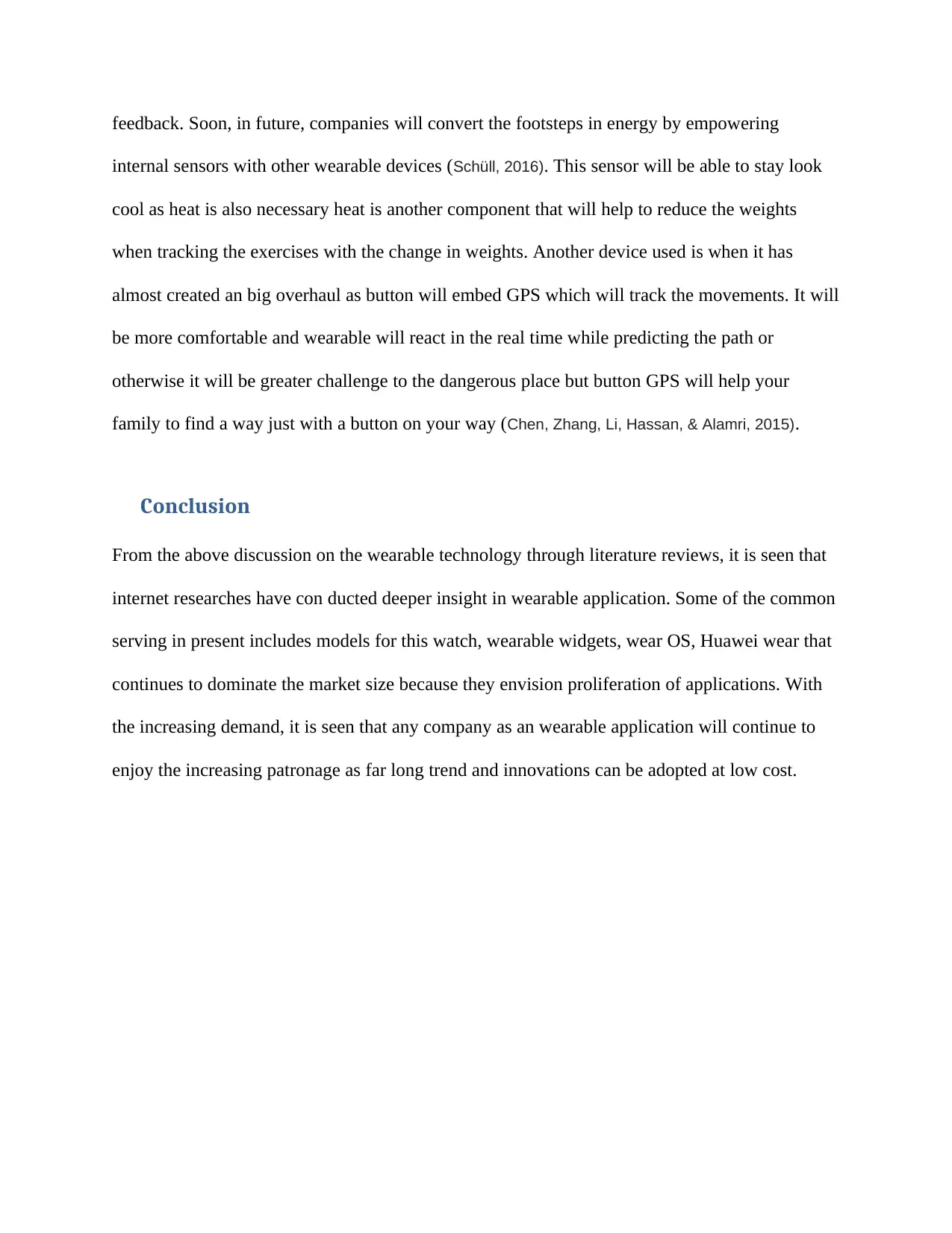
feedback. Soon, in future, companies will convert the footsteps in energy by empowering
internal sensors with other wearable devices (Schüll, 2016). This sensor will be able to stay look
cool as heat is also necessary heat is another component that will help to reduce the weights
when tracking the exercises with the change in weights. Another device used is when it has
almost created an big overhaul as button will embed GPS which will track the movements. It will
be more comfortable and wearable will react in the real time while predicting the path or
otherwise it will be greater challenge to the dangerous place but button GPS will help your
family to find a way just with a button on your way (Chen, Zhang, Li, Hassan, & Alamri, 2015).
Conclusion
From the above discussion on the wearable technology through literature reviews, it is seen that
internet researches have con ducted deeper insight in wearable application. Some of the common
serving in present includes models for this watch, wearable widgets, wear OS, Huawei wear that
continues to dominate the market size because they envision proliferation of applications. With
the increasing demand, it is seen that any company as an wearable application will continue to
enjoy the increasing patronage as far long trend and innovations can be adopted at low cost.
internal sensors with other wearable devices (Schüll, 2016). This sensor will be able to stay look
cool as heat is also necessary heat is another component that will help to reduce the weights
when tracking the exercises with the change in weights. Another device used is when it has
almost created an big overhaul as button will embed GPS which will track the movements. It will
be more comfortable and wearable will react in the real time while predicting the path or
otherwise it will be greater challenge to the dangerous place but button GPS will help your
family to find a way just with a button on your way (Chen, Zhang, Li, Hassan, & Alamri, 2015).
Conclusion
From the above discussion on the wearable technology through literature reviews, it is seen that
internet researches have con ducted deeper insight in wearable application. Some of the common
serving in present includes models for this watch, wearable widgets, wear OS, Huawei wear that
continues to dominate the market size because they envision proliferation of applications. With
the increasing demand, it is seen that any company as an wearable application will continue to
enjoy the increasing patronage as far long trend and innovations can be adopted at low cost.
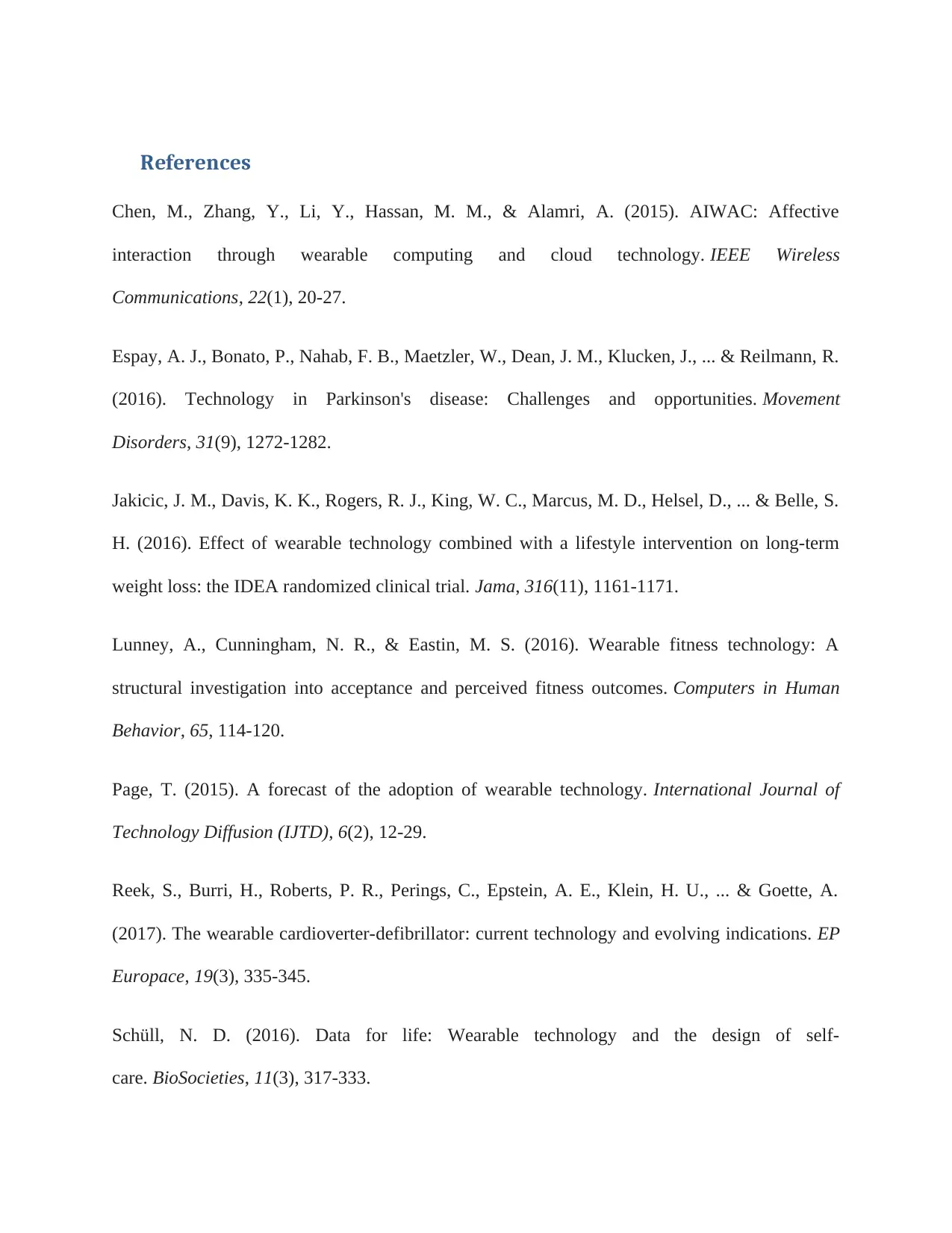
References
Chen, M., Zhang, Y., Li, Y., Hassan, M. M., & Alamri, A. (2015). AIWAC: Affective
interaction through wearable computing and cloud technology. IEEE Wireless
Communications, 22(1), 20-27.
Espay, A. J., Bonato, P., Nahab, F. B., Maetzler, W., Dean, J. M., Klucken, J., ... & Reilmann, R.
(2016). Technology in Parkinson's disease: Challenges and opportunities. Movement
Disorders, 31(9), 1272-1282.
Jakicic, J. M., Davis, K. K., Rogers, R. J., King, W. C., Marcus, M. D., Helsel, D., ... & Belle, S.
H. (2016). Effect of wearable technology combined with a lifestyle intervention on long-term
weight loss: the IDEA randomized clinical trial. Jama, 316(11), 1161-1171.
Lunney, A., Cunningham, N. R., & Eastin, M. S. (2016). Wearable fitness technology: A
structural investigation into acceptance and perceived fitness outcomes. Computers in Human
Behavior, 65, 114-120.
Page, T. (2015). A forecast of the adoption of wearable technology. International Journal of
Technology Diffusion (IJTD), 6(2), 12-29.
Reek, S., Burri, H., Roberts, P. R., Perings, C., Epstein, A. E., Klein, H. U., ... & Goette, A.
(2017). The wearable cardioverter-defibrillator: current technology and evolving indications. EP
Europace, 19(3), 335-345.
Schüll, N. D. (2016). Data for life: Wearable technology and the design of self-
care. BioSocieties, 11(3), 317-333.
Chen, M., Zhang, Y., Li, Y., Hassan, M. M., & Alamri, A. (2015). AIWAC: Affective
interaction through wearable computing and cloud technology. IEEE Wireless
Communications, 22(1), 20-27.
Espay, A. J., Bonato, P., Nahab, F. B., Maetzler, W., Dean, J. M., Klucken, J., ... & Reilmann, R.
(2016). Technology in Parkinson's disease: Challenges and opportunities. Movement
Disorders, 31(9), 1272-1282.
Jakicic, J. M., Davis, K. K., Rogers, R. J., King, W. C., Marcus, M. D., Helsel, D., ... & Belle, S.
H. (2016). Effect of wearable technology combined with a lifestyle intervention on long-term
weight loss: the IDEA randomized clinical trial. Jama, 316(11), 1161-1171.
Lunney, A., Cunningham, N. R., & Eastin, M. S. (2016). Wearable fitness technology: A
structural investigation into acceptance and perceived fitness outcomes. Computers in Human
Behavior, 65, 114-120.
Page, T. (2015). A forecast of the adoption of wearable technology. International Journal of
Technology Diffusion (IJTD), 6(2), 12-29.
Reek, S., Burri, H., Roberts, P. R., Perings, C., Epstein, A. E., Klein, H. U., ... & Goette, A.
(2017). The wearable cardioverter-defibrillator: current technology and evolving indications. EP
Europace, 19(3), 335-345.
Schüll, N. D. (2016). Data for life: Wearable technology and the design of self-
care. BioSocieties, 11(3), 317-333.
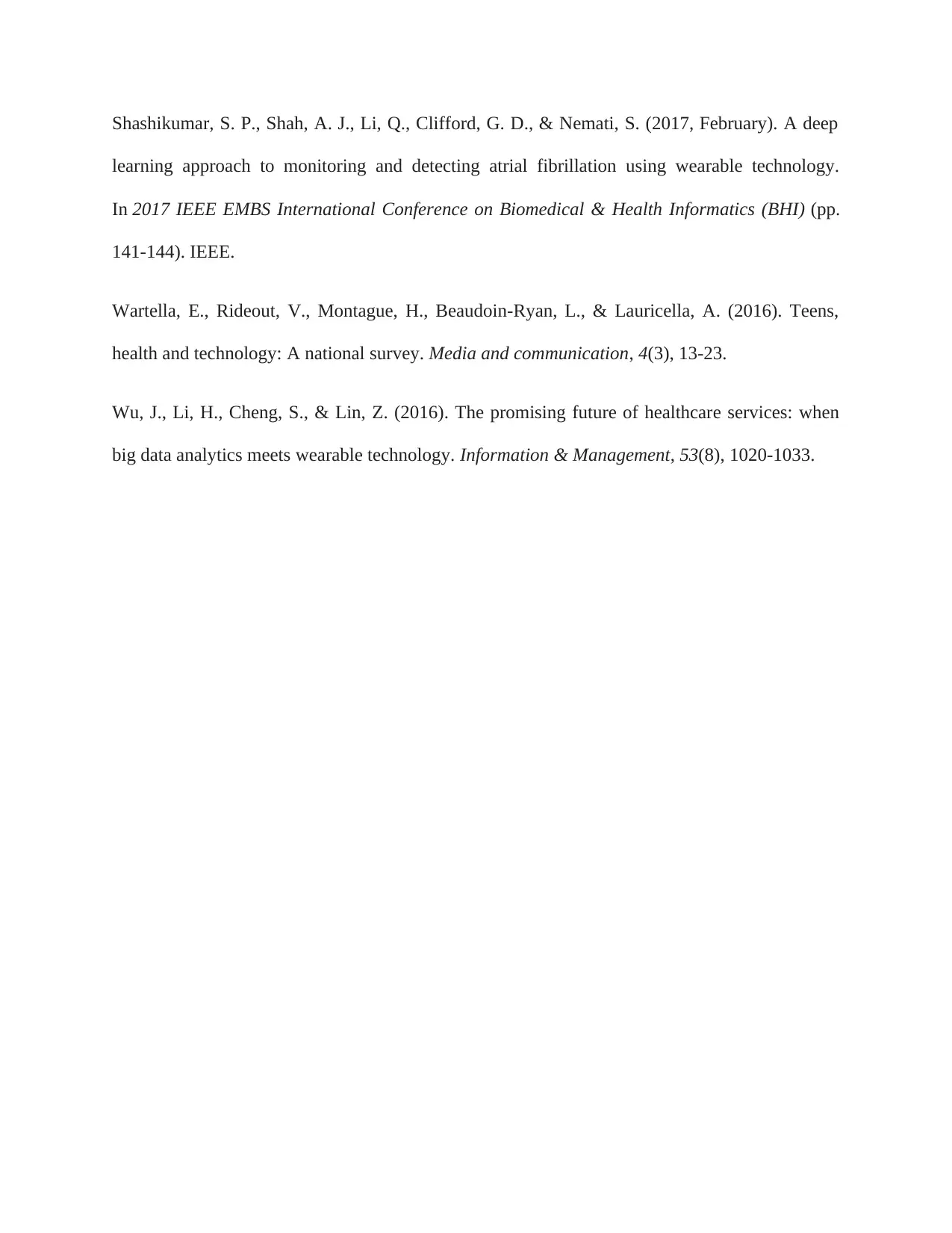
Shashikumar, S. P., Shah, A. J., Li, Q., Clifford, G. D., & Nemati, S. (2017, February). A deep
learning approach to monitoring and detecting atrial fibrillation using wearable technology.
In 2017 IEEE EMBS International Conference on Biomedical & Health Informatics (BHI) (pp.
141-144). IEEE.
Wartella, E., Rideout, V., Montague, H., Beaudoin-Ryan, L., & Lauricella, A. (2016). Teens,
health and technology: A national survey. Media and communication, 4(3), 13-23.
Wu, J., Li, H., Cheng, S., & Lin, Z. (2016). The promising future of healthcare services: when
big data analytics meets wearable technology. Information & Management, 53(8), 1020-1033.
learning approach to monitoring and detecting atrial fibrillation using wearable technology.
In 2017 IEEE EMBS International Conference on Biomedical & Health Informatics (BHI) (pp.
141-144). IEEE.
Wartella, E., Rideout, V., Montague, H., Beaudoin-Ryan, L., & Lauricella, A. (2016). Teens,
health and technology: A national survey. Media and communication, 4(3), 13-23.
Wu, J., Li, H., Cheng, S., & Lin, Z. (2016). The promising future of healthcare services: when
big data analytics meets wearable technology. Information & Management, 53(8), 1020-1033.
1 out of 10
Related Documents
Your All-in-One AI-Powered Toolkit for Academic Success.
+13062052269
info@desklib.com
Available 24*7 on WhatsApp / Email
![[object Object]](/_next/static/media/star-bottom.7253800d.svg)
Unlock your academic potential
© 2024 | Zucol Services PVT LTD | All rights reserved.





